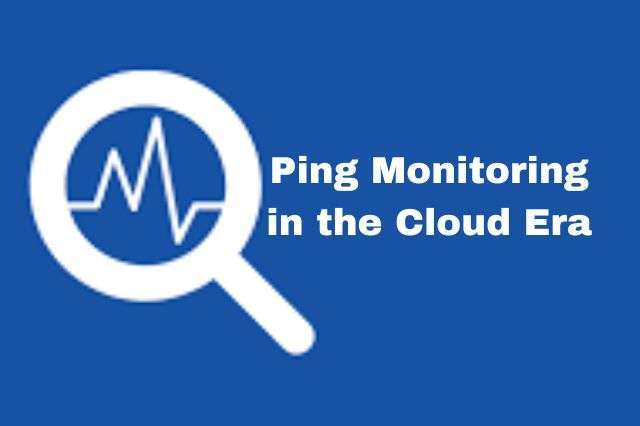Ping Monitoring in the Cloud Era Ensuring Scalability and Security
In a world where data is the lifeblood of business, the importance of seamless connectivity and data availability cannot be overstated. In the era of cloud computing, where the boundaries between on-premises and off-premises infrastructure are blurring, ensuring the performance and security of your network is a mission-critical task. This blog post is your guide to understanding how ping monitoring can help you achieve scalability and security in the cloud era.
What is Ping Monitoring?
Let’s start with the basics. What exactly is ping monitoring? Well, it’s like sending out a friendly “Are you there?” message to your devices and servers. When you send a ping command, it’s a way to check if a remote server or device is online and how quickly it responds. This simple but effective technique has been around for decades and remains an invaluable tool for network administrators.
The Role of Ping in Network Monitoring
Ping monitoring plays a central role in network monitoring. It’s like the heartbeat of your network. When you ping a device or server, you’re checking its availability and response time. If a server is unresponsive or slow to respond, it’s like a doctor detecting an irregular heartbeat. That’s your cue to investigate and address any potential issues before they become critical.
Real-Time Insights
One of the key advantages of ping monitoring is its real-time nature. It provides instant feedback on the status of your devices and servers. This means you can proactively address any issues before they impact your users or business operations. It’s like having a crystal ball that lets you see network problems before they materialize.
The Cloud Era: Challenges and Opportunities
The advent of cloud computing has revolutionized the way businesses operate. It offers scalability, flexibility, and cost-efficiency. However, with great power comes great responsibility. As your infrastructure moves to the cloud, you face new challenges in ensuring the performance and security of your network.
Scalability
Scalability is a double-edged sword. On one hand, the cloud allows you to scale your resources up or down as needed. But on the other hand, it’s easy to lose track of all the moving parts. Imagine a circus performer juggling balls in the air. The more balls you add, the more skill and precision are required. Ping monitoring helps you keep an eye on all those balls (resources) in real-time.
Security
With data stored in the cloud, security is a top concern. It’s like locking your valuables in a bank vault. But what if you don’t know if the vault door is wide open? Ping monitoring acts as your security guard, constantly checking if the door is closed and the alarm system is armed.
How Ping Monitoring Ensures Scalability
Now, let’s dive into how ping monitoring can help ensure scalability in the cloud era.
1. Resource Allocation
In the realm of cloud computing, your expenditure aligns precisely with your consumption. It’s like a buffet where you’re charged per plate. Ping monitoring helps you keep track of your resource consumption. If a server or virtual machine is running without a purpose, it’s like paying for an uneaten plate at the buffet. Ping monitoring helps you identify underutilized resources and make informed decisions on resource allocation.
2. Performance Optimization
Scalability is not just about adding more resources; it’s also about optimizing the performance of existing resources. Ping monitoring gives you insights into the response times of your servers. If a server is struggling to keep up with requests, it’s like a marathon runner hitting the wall. Ping monitoring allows you to identify performance bottlenecks and fine-tune your infrastructure for optimal performance.
3. Automatic Scaling
In the cloud, you can set up automatic scaling rules. It’s like having a self-aware orchestra that adds more musicians when the music gets louder. Ping monitoring can trigger automatic scaling based on predefined conditions. If your website experiences a sudden traffic spike, ping monitoring can detect it and automatically spin up additional server instances to handle the load. It’s like having an on-demand workforce at your disposal.
How Ping Monitoring Ensures Security
In the cloud era, security is paramount. Let’s explore how ping monitoring contributes to your network’s security.
1. Intrusion Detection
Imagine your network is a fortress, and intruders are trying to breach the walls. Ping monitoring serves as your early warning system. It continuously checks for unauthorized access attempts and unusual activities. If an intruder is knocking on the door, ping monitoring will alert you before they break in. It’s like having a vigilant guard at the entrance.
2. Data Center Redundancy
Data centers are the nerve centers of the cloud. They retain and manipulate extensive volumes of data. Ping monitoring ensures the redundancy of data centers. If one data center goes offline, it’s like a power outage in one part of a city. Ping monitoring can detect the outage and redirect traffic to a backup data center, ensuring uninterrupted service. It’s like having backup generators to keep the lights on.
3. Service Availability
Your customers rely on your services to be available 24/7. Downtime is not an option. Ping monitoring verifies the availability of your services. If a service goes down, it’s like a traffic signal turning red. Ping monitoring can immediately alert your team, allowing them to take swift action to restore service. It’s like having a traffic cop who ensures a smooth flow of traffic.
The Ping Monitoring Toolbox
Now that we’ve covered the why and how of ping monitoring in the cloud era, let’s take a look at the essential tools and practices.
1. Ping Tools
Ping monitoring tools come in various flavors. Some are basic and free, while others are feature-rich and come with a price tag. It’s akin to deciding between a pedal-driven cycle and a high-performance automobile. The right tool depends on your specific needs and budget. Some popular ping monitoring tools include Pingdom, SolarWinds Ping Sweep, Pingmonk and PRTG Network Monitor.
2. Alerting and Notifications
Ping monitoring is not just about sending pings; it’s about acting on the results. Most monitoring tools allow you to set up alerts and notifications. It’s like having a personal assistant who taps you on the shoulder when something requires your attention. You can receive alerts via email, SMS, or even integrate with collaboration tools like Slack.
3. Historical Data Analysis
To understand the bigger picture, historical data analysis is crucial. It’s like looking at a graph of a rollercoaster ride; you see the highs, lows, and trends. With historical data, you can identify patterns and make informed decisions about resource allocation and performance optimization.
4. Security Integration
Ping monitoring can work hand in hand with security tools. It’s like having a dedicated security team within your monitoring setup. By integrating with security solutions, you can detect and respond to security threats more effectively. For example, if a server’s response time suddenly spikes, it could be a sign of a DDoS attack, and your security system can automatically take action to mitigate the threat.
5. Cloud Compatibility
In the cloud era, it’s essential that your ping monitoring solution is cloud-compatible. It’s like making sure your car runs on the right type of fuel. Cloud-compatible monitoring tools can seamlessly integrate with your cloud infrastructure, providing a holistic view of your entire network, whether it’s on the cloud or on-premises. This compatibility is crucial in ensuring that no part of your network goes unmonitored.
The Future of Ping Monitoring
As technology continues to advance, ping monitoring is not staying still. It’s evolving to meet the demands of the ever-changing IT landscape. Let’s take a look at what the future holds for ping monitoring.
Machine Learning and AI
Machine learning and artificial intelligence are making their mark on ping monitoring. It’s like giving your monitoring tools a brain of their own. These technologies can analyze historical data, detect anomalies, and predict potential issues before they occur. For example, your monitoring system can learn that response times typically spike at a certain time of day and proactively allocate additional resources during those periods.
IoT and Edge Computing
The Internet of Things (IoT) and edge computing are expanding the network landscape. With devices and sensors at the edge of the network, traditional monitoring methods may not be sufficient. Ping monitoring is adapting to monitor these distributed and diverse devices. It’s like extending your radar to cover a broader area, ensuring that no device, no matter how remote, goes unnoticed.
User Experience Monitoring
It’s not just about server response times; it’s also about the end-user experience. Ping monitoring is shifting towards user experience monitoring, giving you insights into how your users perceive your services. It’s like seeing your website through your customers’ eyes. By understanding the user experience, you can make targeted improvements to enhance satisfaction and loyalty.
Cloud-Native Monitoring
With the rise of cloud-native applications, monitoring is also becoming cloud-native. It’s like evolving from a landline phone to a smartphone. Cloud-native monitoring tools are designed to work seamlessly with cloud-based applications, providing insights into the performance and security of these modern applications. They are built to scale and adapt to the dynamic nature of cloud environments.
Compliance and Reporting
In an era of increasing regulations and compliance requirements, ping monitoring is becoming a valuable tool for demonstrating adherence to these standards. It’s like having a complete audit trail of your network’s performance and security. Ping monitoring can generate reports and logs that help you prove compliance with data protection regulations and industry-specific standards.
Conclusion
In the cloud era, where the stakes are high and network performance and security are paramount, ping monitoring is your trusted ally. It’s like the guardian of your network, constantly checking for vulnerabilities and inefficiencies. With the ability to scale your resources and ensure the security of your data, ping monitoring is a fundamental tool for businesses and organizations of all sizes.
As technology continues to advance and networks become more complex, ping monitoring is adapting and evolving to meet new challenges. Whether it’s through machine learning, user experience monitoring, or compliance reporting, ping monitoring remains at the forefront of network management.
By following best practices and leveraging the real-world benefits of ping monitoring, you can ensure that your network operates at its best, providing a seamless experience for users and maintaining the highest level of security. So, in the ever-evolving cloud era, remember that ping monitoring is your trusted partner in ensuring scalability and security.





